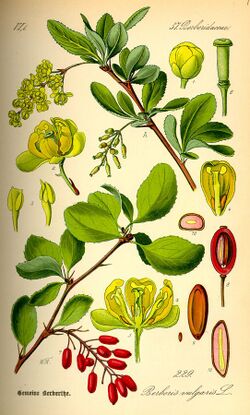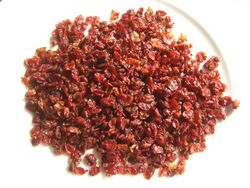Biology:Berberis vulgaris
| Barberry | |
|---|---|

| |
| Berberis vulgaris[1] | |
| Scientific classification | |
| Kingdom: | Plantae |
| Clade: | Tracheophytes |
| Clade: | Angiosperms |
| Clade: | Eudicots |
| Order: | Ranunculales |
| Family: | Berberidaceae |
| Genus: | Berberis |
| Species: | B. vulgaris
|
| Binomial name | |
| Berberis vulgaris | |
| Synonyms[2] | |
|
List
| |
Berberis vulgaris, also known as common barberry,[3] European barberry or simply barberry, is a shrub in the genus Berberis native to the Old World. It produces edible but sharply acidic berries, which people in many countries eat as a tart and refreshing fruit.
Description
It is a deciduous shrub growing up to 4 metres (13 feet) high. The leaves are small oval, 2–5 centimetres (3⁄4–2 inches) long and 1–2 centimetres (1⁄2–3⁄4 in) broad, with a serrated margin; they are borne in clusters of 2–5 together, subtended by a three-branched spine 3–8 millimetres (1⁄8–5⁄16 in) long. The flowers are yellow, 4–6 mm (1⁄8–1⁄4 in) across, produced on 3–6 cm (1 1⁄8–2 3⁄8 in) long panicles in late spring. The fruit is an oblong red berry 7–10 mm (1⁄4–3⁄8 in) long and 3–5 mm (1⁄8–3⁄16 in) broad, ripening in late summer or autumn.
Distribution and habitat
The shrub is native to central and southern Europe, southern England ,[4] northwest Africa and western Asia;[5] it is also naturalised in northern Europe and North America. In the United States and Canada , it has become established in the wild over an area from Nova Scotia to Nebraska, with additional populations in Colorado, Idaho, Washington state, Montana, and British Columbia.[6] It is also cultivated in many countries.
Ecology
The berries are an important food for many small birds, which disperse the seeds in their droppings.
B. vulgaris is the alternate host species of the wheat stem rust fungus (Puccinia graminis f. sp. tritici), a grass-infecting rust fungus that is a serious fungal disease of wheat and related grains. For this reason, cultivation of B. vulgaris is prohibited in Canada[7] and some areas of the US (Connecticut, Massachusetts , Michigan, and New Hampshire).[3]
Uses
The edible berries,[8] though rich in vitamin C, have a very sharp or sour flavor and are not widely consumed because the thorny shrubs make them difficult to harvest.
In Europe, the berries have been traditionally used as an ingredient in making jam. The berries are high in pectin which makes the jam congeal as it cools after having been boiled. In southwestern Asia, especially Iran, the berries are used for cooking, as well as for jam-making. In Iran, barberries are commonly used as a currant in rice pilaf.
زرشک zerešk is the Persian name for the dried fruit of Berberis spp., particularly also that of Berberis integerrima called زرشک بیدانه zerešk bi-dâne, literally 'seedless barberry',[9] which is widely cultivated in Iran. Iran is the largest producer of zerešk.
The South Khorasan province in Iran is the main area of zerešk and saffron production in the world, especially around Birjand and Qaen. About 85% of production is in Qaen and about 15% in Birjand. There is evidence of cultivation of seedless barberry in South Khorasan two hundred years ago.[10] A garden of zerešk is called زرشکستان zerešk-estân. Zerešk is widely used in cooking, imparting a tart flavor to chicken dishes. It is usually cooked with rice, called زرشک پلو zerešk polo, and provides a meal with chicken.
Other uses
The plant has been widely cultivated for hedges in New Zealand.[11]
Salishan people have used "barberry" to treat acne in their traditional medicine, although bark of the native Berberis aquifolium (Oregon grape) and other related species was used.[12] [13] Native American Indians used the roots or berries as a general herbal tonic to stimulate appetite.[14] A decoction of the plant has been used as a folk medicine to treat gastrointestinal ailments and coughs,[15] although its use has been limited due to the bitter taste of the bark and root.[16][17]
See also
- Berberis microphylla, calafate (a related shrub with similar berries, native in temperate South America)
References
- ↑ 1885 illustration from Prof. Dr. Otto Wilhelm Thomé Flora von Deutschland, Österreich und der Schweiz 1885, Gera, Germany
- ↑ The Plant List
- ↑ 3.0 3.1 "Berberis vulgaris". Natural Resources Conservation Service PLANTS Database. USDA. https://plants.usda.gov/core/profile?symbol=BEVU.
- ↑ Plant Atlas 2020
- ↑ Altervista Flora Italiana, Crespino comune, Sowberry, Common Barberry, vinettier, espino cambrón, Sauerdorn, Berberis vulgaris L. includes photos, drawings, and European distribution map
- ↑ Flora of North America vol 3
- ↑ "D-01-04: Plant protection import and domestic movement requirements for barberry (Berberis, Mahoberberis and Mahonia spp.) under the Canadian Barberry Certification Program". 2012-04-03. http://www.inspection.gc.ca/plants/plant-protection/directives/horticulture/d-01-04/eng/1333479606359/1333480359713.
- ↑ Elias, Thomas S.; Dykeman, Peter A. (2009). Edible Wild Plants: A North American Field Guide to Over 200 Natural Foods. New York: Sterling. pp. 219. ISBN 978-1-4027-6715-9. OCLC 244766414. https://www.worldcat.org/oclc/244766414.
- ↑ Alemardan, Ali; Asadi, Wahab; Rezaei, Mehdi; Tabrizi, Leila; Mohammadi, Siavash (2013). "Cultivation of Iranian seedless barberry (Berberis integerrima 'Bidaneh'): A medicinal shrub". Industrial Crops and Products 50: 276–87. doi:10.1016/j.indcrop.2013.07.061.
- ↑ Tehranifar, A. (2003). "Barberry Growing in Iran". in Lee, J-M.; Zhang, D.. XXVI International Horticultural Congress: Asian Plants with Unique Horticultural Potential: Genetic Resources, Cultural Practices, and Utilization. ISHS Acta Horticulturae 620. pp. 193–5. ISBN 978-90-66054-00-4. http://www.actahort.org/books/620/620_21.htm. Retrieved 15 January 2014.
- ↑ Popay, Ian; Champion, Paul; James, Trevor, eds (2010). "Berberis glaucocarpa barberry". An Illustrated Guide to Common Weeds of New Zealand (3rd ed.). Christchurch: New Zealand Plant Protection Society. ISBN 978-0-473-16285-6. http://www.rnzih.org.nz/pages/berberisglaucocarpa.htm.[page needed]
- ↑ Turner, NJ; Hebda, RJ (1990). "Contemporary use of bark for medicine by two Salishan native elders of southeast Vancouver Island, Canada". Journal of Ethnopharmacology 29 (1): 59–72. doi:10.1016/0378-8741(90)90098-e. PMID 2345461.
- ↑ "Berberis aquifolium Pursh | Plants of the World Online | Kew Science". https://powo.science.kew.org/taxon/urn:lsid:ipni.org:names:31334-2.
- ↑ Foster, S; Tyler, VE (1999). Tyler's Honest Herbal (4th ed.). Binghamton, NY: Haworth Press. ISBN 9781136745010. https://books.google.com/books?id=WQBbOjN0T64C&pg=PA43.
- ↑ Schauenberg, P; Paris, F (1977). Guide to Medicinal Plants. New Canaan, CT: Keats Publishing, Inc..
- ↑ Duke, JA (1985). Handbook of Medicinal Herbs. Boca Raton, Florida: CRC Press.
- ↑ Hartwell, JL (1971). "Plants used against cancer. A survey.". Lloydia 34 (4): 386–425. PMID 5173435.
External links
| Wikimedia Commons has media related to Berberis vulgaris. |
Wikidata ☰ Q158563 entry
 |






